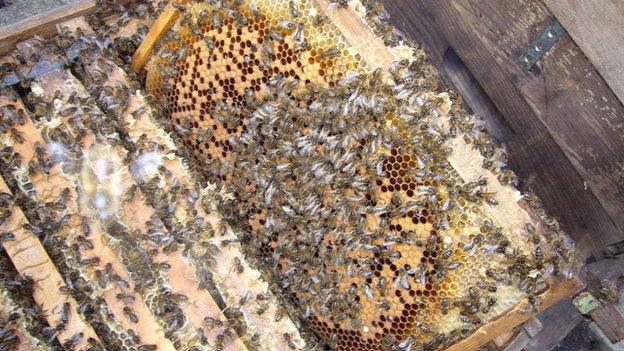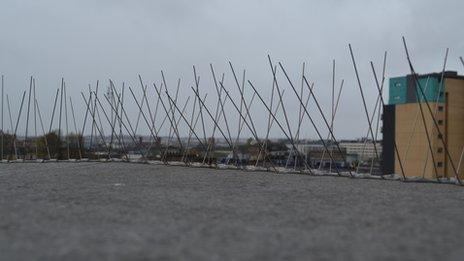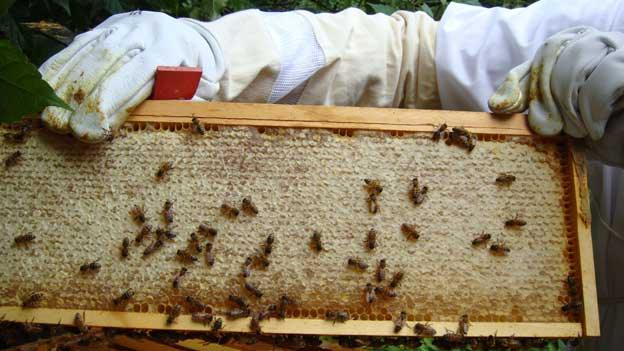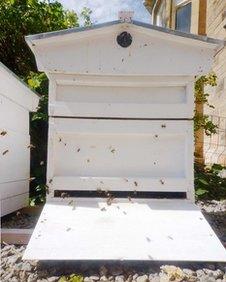Making a bee-line for city roofs
- Published

The cold winter has badly affected bee populations in Scotland and there are threats from other sources including loss of habitat and disease. Could the answer to the decline of bees lie, at least partly, in our towns and cities?
It is a twisting route, through the parts of Glasgow's St Enoch's shopping centre which the public does not usually see, to get to the roof.
It takes a leap of imagination on a wet Glasgow day to picture an area of green-roof alive with flowers, bees and other pollinators, but that is the plan.
At the moment there is one hive on the roof, but more will follow.
"It would be fantastic to see bees and beekeeping on many roofs," says Norton Miller of Johnny's Garden.

The roof of the St Enoch shopping centre is an unexpected location for beekeeping
It is a not-for-profit organisation which is working to increase the number of bees across the city.
As well as the hive on this rooftop, they have others in different areas, as part of the city council's Stalled Spaces project, which aims to revive empty or derelict sites.
On the edge of the shopping centre roof there is sharp wire, framing a cityscape beyond, of tall buildings and the river. It could not be more urban, but Mr Miller sees opportunities.
He says: "If you look around now you can see roofs with so much potential for putting a beehive on.
"Just across St Enoch's square, that's a reasonable flat roof space there, there's a few buildings down towards the river."
The present hive has been placed on a south-facing roof to take advantage of what sun and warmth there is and the bees are being given supplementary feed as a precaution.
When the green roof is planted though they should have plenty to eat.
"It's important to realise that bee hives can't just be stuck in urban space without creating a habitat for them," says Michael Smith, the co-founder of Johnny's Garden.
"I think they call that bee-bling. A lot of people in London have been putting bee hives on their roof and they've been kind of unsuccessful with it, but it's important you realised you have to put a natural habitat there.

The roof of the St Enoch Centre has just one hive so far
"There is a desire, a mindset to keep bees in an urban space. particularly in New York, Paris, London and Glasgow. I think we're at the forefront of an international movement."
On the other side of the river Clyde in the Gorbals, a group of men is hard at work digging out what will eventually be a garden.
Just next to them is a beehive being looked after by the Gorbals Healthy Living Network. It tries to persuade local people to grow their own food and eat more healthily. They became involved with bees last summer.
It has been a positive experience, although the long winter meant this colony did not survive.
They now have plans to restock and expand their beekeeping.
"We use them as an educational tool for the children," says Helen Trainor, chair of the Healthy Living Network.
"It makes them appreciate the environment and how the food chain starts, teaching them about the bees and the plants and the butterflies and how that helps them grow their food."
In a different urban environment just one train stop from the hubbub of Glasgow's central station, another beekeeper is checking on his hives.
Small numbers of bees are making their way in an out of one of them, but there is not all that much activity to be seen.

Bees are also used as an educational tool
"I've got three parks the bees could fly to, they've got very nice gardens and it's a very nice area to keep bees in," says Ed O'Brien.
He was an amateur bee keeper but now does it on a more commercial basis.
He has a dozen or so hives around the area and others in different parts of the city.
He supplies honey to neighbours, shops and others. He used to have more hives but some colonies died over the winter.
There are also challenges from bee diseases, although he believes pesticides are not a major issue in the city.
But the real advantage for urban bees in his view is the sheer variety of plants they can reach.
"The way farming is now with crops, it can be what you call a mono-culture where you've got three months of one feed and that's all." adds Ed O'Brien. He contrasts that with what bees can get in towns.
"In spring time you've got bluebells, snowdrops and daffodils, through to, I think the finest time of all in July, when you get the lime trees out and the bees are just everywhere.
"I've got a cotoneaster plant which just turns into a living sculpture with bees and then at the back end, you've got all the ivy, which is great winter feed for them."
But looking around the garden it is greener than it usually would be at this time.
There are fewer flowers and so less pollen about.

Hives come in many different designs
Ed O'Brien says he is about a month behind schedule and while his colony losses are "very sad," they are sustainable.
On a Scotland-wide scale bee farmers estimate that about 4,000 colonies have been lost to the prolonged winter and there has been the promise from the Scottish government of help for commercial bee farmers to restock.
"Bees are reasonably well equipped to handle bad weather at the appropriate times," says Norton Miller.
"So in winter, if it's below freezing, that's fine, but what we've noticed is that the past three autumn/winters, have been relatively mild, surprisingly, but at the wrong time.
"So November, December has been mild and our bees have been out flying.
"There's no food for them but they're expending energy and then our real winter hits, January, February and they have possibly insufficient honey reserves."
But urban bees are not confined to a managed honey bee population.
There is also the wild bumble bees and the solitary bees.
As the name suggests solitary bees are lone operators, while bumble and honey bees are social and live in colonies. They are key pollinators.
"One of the main reasons bumble bees have been declining over the last 70, 80 years has been changes in the landscape," explains Dawn Ewing, outreach manager of the Bumblebee Conservation Trust.
She adds that for a healthy environment you need all kinds of bees because they pollinate different plants.
"There just aren't enough flowers in the countryside anymore and gardeners have a perfect opportunity to address that by ensuring that they are havens, oases for bumble bees in their gardens by ensuring that there are lots of flowers."
Glasgow already has scores of public parks and gardens and enthusiasts argue that can give the city-dwelling bee a real boost.
"The fascination is watching the colony at work," says Ed O'Brien.
"In there you've got everything from the queen herself, they take their dead out, they've got undertaker bees in there, they've got nursery bees.
"The amount of time I've spend just watching them coming in with pollen and trying to work out where that pollen has come from. They're happy bees, it's a great place for bees, the city."